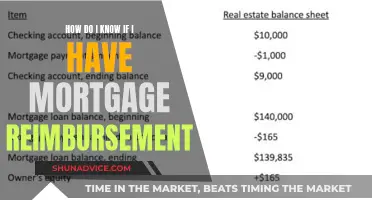
An assumable mortgage is an arrangement in which an outstanding mortgage and its terms are transferred from the current owner to a buyer. This means that instead of applying for a new loan, the buyer takes over the existing one. Assumable mortgages are hard to find as they are usually government-backed loans, and conventional mortgages are generally not assumable. To find out if a mortgage is assumable, look for an assumption clause in your mortgage contract. If the seller is aware they have an assumable mortgage, they will often put that information in the listing. You can also search pre-foreclosure listings and reach out to the owners to see if they would be open to selling the home with an assumable mortgage.
Characteristics and their values regarding assumable mortgages:
| Characteristics | Values |
|---|---|
| Definition | An arrangement in which an outstanding mortgage and its terms are transferred from the current owner to a buyer. |
| Advantage | Buyers can take advantage of lower interest rates compared to the current market rates. |
| Types | USDA, FHA, and VA loans are assumable when certain criteria are met. |
| Requirements | Buyers must qualify for the mortgage to assume it. |
| Costs | Buyers may need to pay a substantial down payment or secure a new loan for the difference in the sale price and the existing mortgage. |
| Simple assumption | A private transfer of responsibility for the mortgage from the seller to the buyer without the mortgage lender's approval. |
| Special circumstances | Conventional loans may be assumable in certain cases, such as inheritance or divorce. |
| Verification | Check the loan agreement or mortgage contract for an assumption clause. |
| Lender approval | The lender must approve the assumption and release the original borrower from liability. |
| Seller's role | The seller may advertise the property as having an assumable mortgage. |
| Public records | County recorders or registers of deeds may have publicly available information on property loan information. |
What You'll Learn

What are the pros and cons of an assumable mortgage?
An assumable mortgage is an arrangement where an outstanding mortgage and its terms are transferred from the current owner to a buyer. In other words, the buyer assumes or takes over the existing mortgage from the seller. This means that the buyer takes the seller's place as the responsible party for the loan, which is already partway paid off.
Assumable mortgages are typically government-backed mortgages, including Federal Housing Administration (FHA) loans, U.S. Department of Veterans Affairs (VA) loans, and U.S. Department of Agriculture (USDA) loans. Conventional loans are generally not assumable.
Pros of an Assumable Mortgage
Assumable mortgages can be beneficial for buyers, especially in a high-interest rate environment. Here are some advantages:
- Lower interest rates: Buyers can take advantage of lower interest rates if they are higher at the time of purchase than when the seller originally purchased the home. This can result in long-term savings compared to a new mortgage.
- Cost savings: Assumable mortgages can lead to cost savings as buyers avoid the rigorous process of obtaining a new home loan from a bank, which may have higher interest rates. Additionally, there are capped closing costs for FHA, VA, and USDA loans, resulting in further savings.
- No new home appraisal: When assuming a mortgage, a new home appraisal is typically not required, simplifying the process.
Cons of an Assumable Mortgage
While assumable mortgages offer benefits, there are also some drawbacks to consider:
- Down payment: Buyers may need to make a substantial down payment if the seller has a lot of home equity. This is to compensate for the difference between the purchase price and the existing mortgage balance.
- Second mortgage: In some cases, the buyer may need to take out a second mortgage to secure additional funds if the home's purchase price exceeds the mortgage balance by a significant amount. This second loan may have a higher interest rate and could involve a different lender, posing potential challenges.
- Limited loan options: Assumable mortgages are not available for all loan types. Conventional loans are typically not assumable, and even for government-backed loans, there may be special criteria and approval processes to meet.
- Mortgage insurance: Assuming certain types of loans, such as FHA and USDA loans, may result in inheriting mortgage insurance premiums, which can add to the overall cost.
- Time and approval process: The approval process for an assumable mortgage can be lengthy, taking anywhere from 2 to 6 months or even longer. Lenders may not be keen on assumptions as they do not generate new interest rates or clients from these transactions.
Finding Non-Recourse Mortgages: What You Need to Know
You may want to see also

How do I find assumable mortgages?
Assumable mortgages are hard to find as they are not very common. They are also not easy to find on Zillow, and most agents, sellers, and lenders don't know how the assumption process works.
However, there are some platforms that can help you find assumable mortgages. One such platform is "Roam", which compiles available listings with low-rate assumable mortgages for you to browse. To get started, enter the city, state, zip code, or school district you’re interested in purchasing in. Utilize the search filters to narrow down your search. You can also save your search preferences and activate listing notifications. Once you’ve found a home and are ready to make an offer, you can schedule a call with a Roam Advisor directly from the listing. Your Roam Advisor will guide you through each step of the process, while also working directly with your agent, the servicer, and the seller to ensure you close on time. Note that to qualify, you must meet the current FHA, VA, or USDA loan requirements depending on the type of loan you are assuming. This typically means a minimum credit score of 580, although most lenders prefer 620-640.
Another platform that can help you find assumable mortgages is "AssumeList". AssumeList is a unique real estate tool that allows prospective homebuyers, investors, and agents to find homes for sale with VA, FHA, and USDA assumable mortgages, regardless of whether they are actively listed or off-market. 100% of AssumeList homes contain an interest rate below 5%, with the vast majority having rates of 3% or lower. AssumeList maintains the largest network of experienced agents to help you buy a home with an assumable mortgage, at no additional cost.
A third platform that can help you find assumable mortgages is "Assumable". This platform allows you to search for active assumable mortgage listings near you, along with the existing interest rate, potential savings, and more. Assumable loans are typically government-backed FHA, VA, and USDA mortgages. To assume one of these loans, you will need to meet the requirements of the lender on the existing mortgage, which typically includes evaluating your credit score, income, and other factors.
You can also try to find assumable mortgages by searching public records for houses you are interested in and checking if the mortgage note says it is assumable. You could also subscribe to a database product like Property Radar, or find a capable agent who can do this legwork for you.
Finding Your Hamp Mortgage Servicer: Who and How?
You may want to see also

What are the costs of assuming a mortgage?
Assuming a mortgage can be a great option when current mortgage rates are high, as it allows you to take advantage of a lower interest rate. However, there are still costs involved in assuming a mortgage that you should be aware of. Here are some of the key costs you may encounter:
Reimbursing the Seller for Their Equity
When you assume a mortgage, you will need to reimburse the seller for the equity they have built up in the property. This could be a substantial cost, depending on how much equity the seller has. For example, if the seller has a $300,000 loan balance on a $435,000 home, the buyer will need to pay the difference of $135,000 to compensate the seller for their equity.
Assumption Fee
In addition to reimbursing the seller for their equity, you will also typically need to pay an assumption fee. This is a fee charged by the lender for allowing you to assume the mortgage. For FHA loans, the assumption fee is capped at $1,800, while for VA loans, it is a maximum of $300.
Closing Costs
While assuming a mortgage can lead to lower closing costs compared to a traditional mortgage, there are still closing costs involved. These can include fees for items such as title insurance, escrow, and recording fees. Closing costs typically range from 2-5% of the loan amount, but they may be capped in some cases.
Mortgage Insurance Costs
If you are assuming an FHA or USDA loan, you may be required to pay ongoing mortgage insurance premiums. These premiums are always required on these types of mortgages and can add to the overall cost of assuming the mortgage.
Second Mortgage
In some cases, you may need to take out a second mortgage to cover the difference between the sale price of the home and the existing mortgage balance. This can occur when the seller has a significant amount of equity in the home. The interest rate on the second mortgage may be higher than the assumed mortgage, increasing the overall cost of borrowing.
Other Costs
There may be additional costs involved in assuming a mortgage, such as costs related to government-backed loans. For example, if you assume a VA loan, you may need to pay a funding fee. There may also be costs associated with the application process, such as credit check fees or other lender-specific fees.
It's important to carefully review the loan agreement and understand all the costs involved before assuming a mortgage. While it can offer the advantage of a lower interest rate, there are still significant costs that you should be prepared for.
Finding Homeowner Mortgage Details: A Property Guide
You may want to see also

What is the process of assuming a mortgage?
An assumable mortgage is a type of home financing arrangement where an outstanding mortgage and its terms are transferred from the current owner to the buyer. The buyer can avoid obtaining their own mortgage, which may have a higher interest rate.
The process of assuming a mortgage can be complex and costly, and not all buyers will qualify. It is important to fully understand the pros and cons of this type of mortgage before formally committing.
- Confirm that the loan is assumable: Verify this by carefully reviewing the loan agreement or asking the existing lender. The lender can also confirm that the loan is in good standing.
- Prepare for the costs: You will need to make a down payment, but the amount depends on how much equity the seller has. You will also have to pay an assumption fee and potentially other costs.
- Submit your application: The process of assuming a mortgage varies from lender to lender, but in general, you will need to fill out an application, provide proof of income and assets, and submit to a credit check.
- Close and sign liability release: If the assumption is approved, you will need to fill out paperwork just as you would when closing any other type of home loan. This includes signing a release of liability confirming that the seller is no longer responsible for the mortgage.
It is important to note that not all home loans are assumable. Most conventional mortgages, those not backed by a government agency but rather by a private lender, are not assumable. Government-backed mortgages, such as Federal Housing Administration (FHA) loans, U.S. Department of Veterans Affairs (VA) loans, and U.S. Department of Agriculture (USDA) loans, are assumable when certain criteria are met.
For example, for FHA loans, both the buyer and seller must meet specific criteria, such as the property being used as the seller's primary residence. VA loans do not require the buyer to be a member of the military to qualify, but the seller may prefer to accept an offer from a qualified military borrower to keep their VA loan entitlement. USDA loans are offered to buyers of rural properties and require the buyer to meet standard qualifications, such as credit and income requirements, and receive approval from the USDA.
Is Your Mortgage Current? How to Check and Confirm
You may want to see also

How do I assume a mortgage outside of a traditional real estate transaction?
An assumable mortgage is a type of home financing arrangement where an outstanding mortgage and its terms are transferred from the current owner to the buyer. This means that instead of applying for a new loan, the buyer can take over or "assume" an existing one. This is particularly attractive to buyers when current mortgage rates are high and closing costs are lower than those associated with traditional mortgages.
Mortgage assumptions can happen outside of traditional real estate transactions. For example, a family member or someone with close ties to the seller may be able to assume an existing mortgage on a home they've inherited. If one person is awarded sole ownership of a property in divorce proceedings, that person may be able to assume the full existing mortgage themselves. In both cases, assumption is allowed even if the contract doesn’t include an assumption clause, or if it’s a conventional loan.
Simple assumption is a less common way to assume a mortgage. It's a private transfer of responsibility for the mortgage from the seller to the buyer without the mortgage lender's approval. This is a riskier transaction because if the buyer fails to make payments, both the buyer and seller are liable.
To assume a mortgage outside of a traditional real estate transaction, you'll need to:
- Confirm that the loan is assumable by reviewing the loan agreement.
- Verify that you meet the qualifications, including being creditworthy.
- Reimbursing the seller for their equity.
- Pay an assumption fee, which is typically a percentage of the loan amount.
- Cover costs related to government-backed loans, such as a funding fee for a VA loan.
- Pay real estate transfer taxes, depending on the state.
Finding an Old Mortgage Account: Tips and Tricks
You may want to see also
Frequently asked questions
An assumable mortgage is an arrangement in which an outstanding mortgage and its terms are transferred from the current owner to a buyer. The buyer takes on the existing loan with its lower rate, rather than taking on a new loan to finance the property.
If the seller is aware and advertising the property as having an assumable mortgage, they will likely include this in the listing. You can also search for assumable in available listings and pre-foreclosure listings. You can also search for loan information in public records, by searching for terms like "county recorder" or "deeds registry" in Google for your county.
Assumable mortgages are attractive to buyers when current mortgage rates are high, as they can take on an existing loan with a lower rate. Closing costs are also considerably lower than those associated with traditional mortgages.
The buyer may need to pay a substantial down payment or secure a new loan for the difference in the sale price and the existing mortgage. The buyer must still qualify with the agency and lender, and the lender must approve the assumption.







